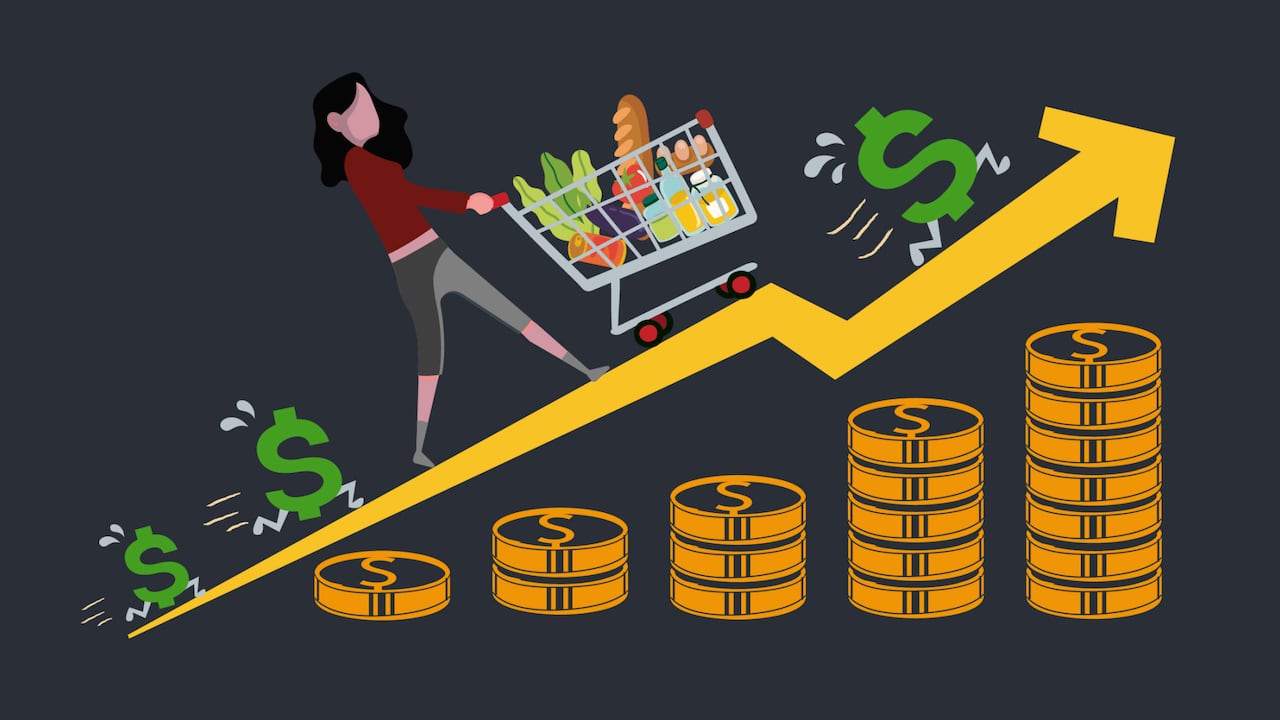In the contemporary global economic landscape, few phenomena exert as profound and pervasive an influence on personal wealth as inflation. Far from being an abstract economic term confined to financial news headlines, inflation directly impacts the purchasing power of every dollar you earn, save, and invest. For individuals striving to safeguard their financial future, navigating the complexities of rising prices is no longer merely prudent; it’s an urgent necessity. This article, crafted for a broad audience and optimized for high Google AdSense revenue, delves deep into the multifaceted nature of inflation, dissecting its causes, dissecting its far-reaching effects on various financial aspects, and crucially, equipping you with actionable, research-backed strategies to not only survive but thrive amidst inflationary pressures. Understanding this economic force is paramount for anyone committed to preserving and growing their financial stability.
Inflation: The Erosion of Purchasing Power
At its core, inflation represents the rate at which the general level of prices for goods and services is rising, and consequently, the purchasing power of currency is falling. When inflation occurs, a unit of currency buys fewer goods and services than it could in prior periods. This isn’t about an isolated price hike in a single product; it’s about a broad, sustained increase across the economy. While central banks often target a low, stable rate of inflation (typically around 2-3% annually) as a sign of a healthy, growing economy, uncontrolled or high inflation can be deeply corrosive to financial well-being.
The principal types of inflation often discussed include:
A. Demand-Pull Inflation: This occurs when aggregate demand in an economy outpaces aggregate supply. Essentially, “too much money chasing too few goods.” Factors contributing to this include rapid economic growth, increased government spending, a surge in consumer confidence, or expansionary monetary policies that inject more money into the system. As demand escalates, businesses raise prices because they can, leading to inflation. B. Cost-Push Inflation: This type of inflation arises from an increase in the costs of production for goods and services. When the cost of raw materials, labor (wages), or energy goes up, businesses pass these increased expenses onto consumers in the form of higher prices. Supply chain disruptions, natural disasters impacting resources, or unionized labor demanding higher wages can trigger cost-push inflation. C. Built-In Inflation (Wage-Price Spiral): This type is largely psychological and self-fulfilling. It occurs when workers demand higher wages to compensate for rising prices, and businesses then raise prices further to cover the increased labor costs. This creates a continuous cycle where rising wages fuel rising prices, which in turn fuel demands for even higher wages, perpetuating the inflationary cycle. D. Monetary Inflation: Directly linked to an excessive increase in the money supply by central banks. When more money is printed or made available in the economy without a corresponding increase in goods and services, the value of each unit of currency diminishes, leading to higher prices.
Understanding these underlying mechanisms is crucial for comprehending why inflation impacts your finances so profoundly. It’s not just a number; it’s a reflection of economic forces at play.
The Insidious Effects of Inflation on Your Finances
Inflation, even at moderate levels, acts as a silent tax, stealthily eroding the value of your money. Its impact is multifaceted, affecting various aspects of your financial life in distinct ways.
A. Erosion of Purchasing Power: This is the most direct and noticeable effect. The same amount of money buys less today than it did yesterday. Your salary might remain the same, but its real value (what it can buy) diminishes. This means your daily living expenses—groceries, fuel, utilities, housing—become more expensive relative to your income, squeezing your budget.
B. Diminished Savings Value: Money held in traditional savings accounts or under the mattress is particularly vulnerable. If your savings account offers an interest rate of 1% and inflation is 5%, your “real” return is -4%. In essence, your money is losing value over time, rather than growing. This incentivizes seeking higher-yielding investments, which often come with greater risk.
C. Impact on Fixed Incomes and Retirees: Individuals living on fixed incomes, such as retirees relying on pensions or social security, are disproportionately affected. Their income doesn’t adjust to the rising cost of living, drastically reducing their standard of living over time. The purchasing power of their lifelong savings dwindles with each passing year of inflation.
D. Uncertainty for Businesses and Consumers: High or volatile inflation creates economic uncertainty. Businesses become hesitant to invest and expand due to unpredictable costs and consumer demand, potentially leading to slower economic growth and job losses. Consumers postpone large purchases, fearing even higher prices later, or cut back on discretionary spending, further dampening economic activity.
E. Borrowing and Lending Dynamics:
1. For Borrowers: In a high-inflation environment, borrowers with fixed-rate loans (like a fixed-rate mortgage) can benefit, as they repay their debt with money that is effectively worth less than when they borrowed it. However, variable-rate loans will see interest rates rise, increasing monthly payments.
2. For Lenders: Lenders are typically disadvantaged by unexpected inflation, as the money they receive back is worth less than the money they lent out. This is why interest rates often rise during inflationary periods to compensate lenders for this erosion of value.
F. Investment Volatility and Risk: Inflation introduces significant volatility into investment markets. Bonds, especially long-term ones, suffer as their fixed interest payments lose value. Stocks can be a mixed bag; some companies can pass on costs and even thrive, while others struggle with rising input costs and reduced consumer spending. Real estate, historically seen as an inflation hedge, can see prices soar but also faces higher interest rates on mortgages.
G. Impact on Debt and Credit: While fixed-rate debt becomes cheaper in real terms for the borrower, inflation also tends to push interest rates higher across the board. This makes new borrowing more expensive, impacting mortgages, car loans, and credit card debt. For those with variable-rate debt, monthly payments can increase significantly, straining budgets.
H. Increased Cost of Doing Business: Businesses face higher costs for raw materials, transportation, energy, and labor. This can squeeze profit margins, forcing them to either absorb costs (reducing profitability), pass them on to consumers (contributing to further inflation), or cut back on production and employment.
Understanding these ripple effects is the first step toward developing robust strategies to protect your finances.
Proactive Strategies to Counter Inflation’s Grip
While inflation is an external economic force, individuals are not powerless. Implementing proactive and strategic measures can significantly mitigate its adverse effects and even turn it into an opportunity.
A. Diversify Your Investments: Beyond Cash
Relying solely on cash or low-interest savings accounts during inflationary periods is akin to watching your money evaporate. Strategic investment diversification is crucial.
- Inflation-Hedge Assets:
- Real Estate: Historically, real estate has been considered a strong hedge against inflation. Property values and rental incomes tend to rise with inflation. Investing in physical property, Real Estate Investment Trusts (REITs), or real estate funds can offer protection.
- Commodities: Raw materials like gold, silver, oil, and agricultural products often perform well during inflationary times because their prices rise directly with inflation. Gold, in particular, is a traditional safe haven.
- Treasury Inflation-Protected Securities (TIPS): These are U.S. Treasury bonds whose principal value adjusts with inflation (measured by the Consumer Price Index or CPI). When the CPI rises, the principal value of the TIPS increases, and vice versa. This protects investors from inflation’s erosion of value.
- Equities (Stocks) in Resilient Sectors: While volatile, certain stocks can perform well. Look for companies that:
- Have strong pricing power (can easily pass on increased costs to consumers). Examples include consumer staples, healthcare, and utilities.
- Are in industries that benefit from rising commodity prices (e.g., energy, materials).
- Have low debt levels and strong cash flows to weather rising interest rates.
- Alternative Investments: Consider exploring assets like art, collectibles, or even certain cryptocurrencies (though highly volatile) that are not directly tied to traditional financial markets and can retain or increase value in inflationary environments. However, these often require specialized knowledge and carry higher risks.
- Avoid Excessive Cash Holdings: Keep only enough cash for immediate expenses and emergencies. Beyond that, deploy funds into assets that have a better chance of keeping pace with or outperforming inflation.
B. Evaluate and Optimize Your Debt Strategy
Inflation affects debt differently depending on whether it’s fixed or variable, and your overall financial position.
- Prioritize Fixed-Rate Debt: If you have fixed-rate loans (e.g., a 30-year fixed-rate mortgage), inflation can actually work in your favor as you repay the debt with money that’s less valuable in real terms. Avoid refinancing these into variable rates unless interest rates are expected to fall significantly.
- Address Variable-Rate Debt: Actively pay down high-interest, variable-rate debt, such as credit card balances or lines of credit. As interest rates rise with inflation, the cost of servicing this debt will increase, potentially spiraling out of control.
- Strategic Borrowing: If you must borrow, consider fixed-rate loans during inflationary periods to lock in current rates before they climb higher. Avoid taking on new debt for depreciating assets.
C. Protect Your Income and Earning Power
Your ability to earn and negotiate is a crucial defense against inflation.
- Negotiate Salary Increases: Don’t be afraid to ask for a raise that at least matches the inflation rate, if not exceeds it, to maintain your real income. Highlight your value and contributions to your employer.
- Develop In-Demand Skills: Invest in yourself through education and training to acquire skills that are highly valued and less susceptible to economic downturns. This increases your marketability and bargaining power.
- Consider a Side Hustle or Passive Income: Diversifying your income streams can provide a buffer against rising costs. Explore passive income opportunities like rental properties, dividend stocks, or online content creation.
- Union Membership: For some professions, unionization can provide collective bargaining power for wage increases that keep pace with inflation.
- Performance-Based Compensation: Seek jobs or roles with compensation structures that include performance-based bonuses or commissions, which can offer a way to increase earnings beyond a fixed salary.
D. Optimize Your Budget and Spending Habits
Mindful spending and smart budgeting become even more critical during inflationary times.
- Track and Analyze Spending: Understand exactly where your money is going. Use budgeting apps or spreadsheets to identify areas where you can cut back.
- Reduce Discretionary Spending: Prioritize essential needs over wants. Look for opportunities to reduce expenses on dining out, entertainment, and non-essential subscriptions.
- Bulk Buying (Strategically): For non-perishable goods you regularly use, buying in bulk when prices are stable or on sale can lock in lower costs.
- Embrace Frugality and DIY: Cook at home more often, perform minor home repairs yourself, and look for cost-saving alternatives in daily life.
- Shop Smarter: Compare prices, use loyalty programs, and look for discounts and sales. Consider generic brands for certain products.
- Energy Efficiency: Invest in energy-efficient appliances, seal drafts, and adjust thermostats to lower utility bills, which are often hit hard by inflation.
E. Review and Adjust Your Retirement Planning
Inflation poses a significant threat to long-term savings, especially for retirement.
- Increase Contributions: If possible, increase your contributions to retirement accounts (401(k), IRA) to outpace inflation. Take full advantage of employer matching programs.
- Allocate to Growth Assets: Ensure a significant portion of your retirement portfolio is allocated to growth-oriented assets like stocks and real estate, which have historically outperformed inflation over the long term. Avoid being overly conservative with cash or bonds.
- Consider Inflation-Adjusted Annuities: As you approach retirement, explore annuities that offer inflation adjustments to ensure your income keeps pace with rising living costs.
- Long-Term Care Planning: Factor in the rising cost of healthcare and long-term care, which often inflates at a higher rate than general consumer prices.
F. Leverage Technology and Digital Tools
Modern tools can provide invaluable assistance in navigating inflation.
- Budgeting Apps: Utilize apps like Mint, YNAB, or Personal Capital to track spending, categorize expenses, and set financial goals.
- Investment Platforms: Use online brokerage accounts to diversify investments and access inflation-hedging assets.
- Price Comparison Websites: Before making purchases, use online tools to compare prices across different retailers.
- Financial News Aggregators: Stay informed about economic trends and inflation forecasts to make timely financial decisions.
- Credit Score Monitoring: Keep an eye on your credit score, as higher scores can secure better interest rates on loans, mitigating the impact of rising rates due to inflation.
Beyond Personal Finance: Systemic Inflationary Pressures
While individual strategies are crucial, understanding the broader systemic forces driving inflation provides context and helps anticipate future trends.
A. Global Supply Chain Disruptions
Events like pandemics, geopolitical conflicts, and natural disasters can severely disrupt global supply chains, leading to shortages of raw materials, components, and finished goods. This reduced supply, coupled with persistent demand, directly contributes to cost-push inflation. The inability of supply chains to quickly adapt creates bottlenecks that perpetuate price increases.
B. Geopolitical Tensions and Energy Prices
Geopolitical instability, particularly in oil-producing regions, can cause sudden spikes in crude oil and natural gas prices. As energy is a fundamental input for almost all goods and services (transportation, manufacturing, heating), these increases ripple throughout the entire economy, leading to widespread inflation. Energy security is increasingly linked to price stability.
C. Fiscal and Monetary Policies
Government spending (fiscal policy) and central bank actions (monetary policy) play a significant role.
- Expansionary Fiscal Policy: Large government spending programs (e.g., infrastructure, stimulus packages) inject money into the economy, potentially fueling demand-pull inflation if supply cannot keep up.
- Expansionary Monetary Policy: Central banks lowering interest rates, engaging in quantitative easing (printing money to buy bonds), or generally increasing the money supply can lead to monetary inflation by devaluing the currency and making borrowing cheaper, thus stimulating demand.
- Contractionary Policies: Conversely, central banks raising interest rates (tightening monetary policy) aims to cool down an overheating economy and curb inflation by making borrowing more expensive and slowing demand.
D. Labor Market Dynamics
A tight labor market, characterized by low unemployment and high demand for workers, can lead to upward pressure on wages. While beneficial for workers, if wage increases outpace productivity gains, businesses may pass these higher labor costs onto consumers, contributing to cost-push and built-in inflation (the wage-price spiral).
E. Climate Change and Resource Scarcity
The long-term impacts of climate change, including extreme weather events, can affect agricultural yields, disrupt transportation routes, and strain resources like water and energy. This increasing scarcity and unpredictability can lead to higher prices for food and other essential goods, contributing to persistent inflationary pressures. The transition to green energy, while necessary, can also bring short-term cost increases.
Navigating the New Economic Reality

Inflation is an undeniable force in the modern economic environment, subtly but powerfully reshaping the financial landscape for individuals and households globally. Ignoring its presence is akin to allowing a hidden drain to steadily deplete your hard-earned wealth. From eroding the purchasing power of your income and savings to introducing volatility into investment portfolios, its effects are comprehensive and pervasive. However, as this guide has thoroughly explored, being informed and proactive is your most potent defense.
By strategically diversifying your investments into assets historically resilient to inflationary pressures (like real estate, commodities, and certain equities), optimizing your debt structure to favor fixed-rate liabilities, and relentlessly focusing on enhancing your earning power through skill development and income diversification, you can build a more robust financial shield. Furthermore, diligently budgeting, making conscious spending choices, and adapting your retirement planning to account for long-term price increases are critical steps in preserving your future well-being.
The current economic reality, marked by intricate global supply chains, evolving geopolitical dynamics, and changing labor markets, suggests that inflationary pressures may become a more recurring feature rather than a transient anomaly. Therefore, continuously educating yourself, staying agile in your financial decision-making, and leveraging available technological tools are no longer just good practices—they are essential survival strategies for maintaining and growing your wealth. Embracing these proactive measures allows you to transform the challenge of inflation into an opportunity for financial resilience and, by sharing this critical knowledge, to significantly enhance your online presence and AdSense earnings.








